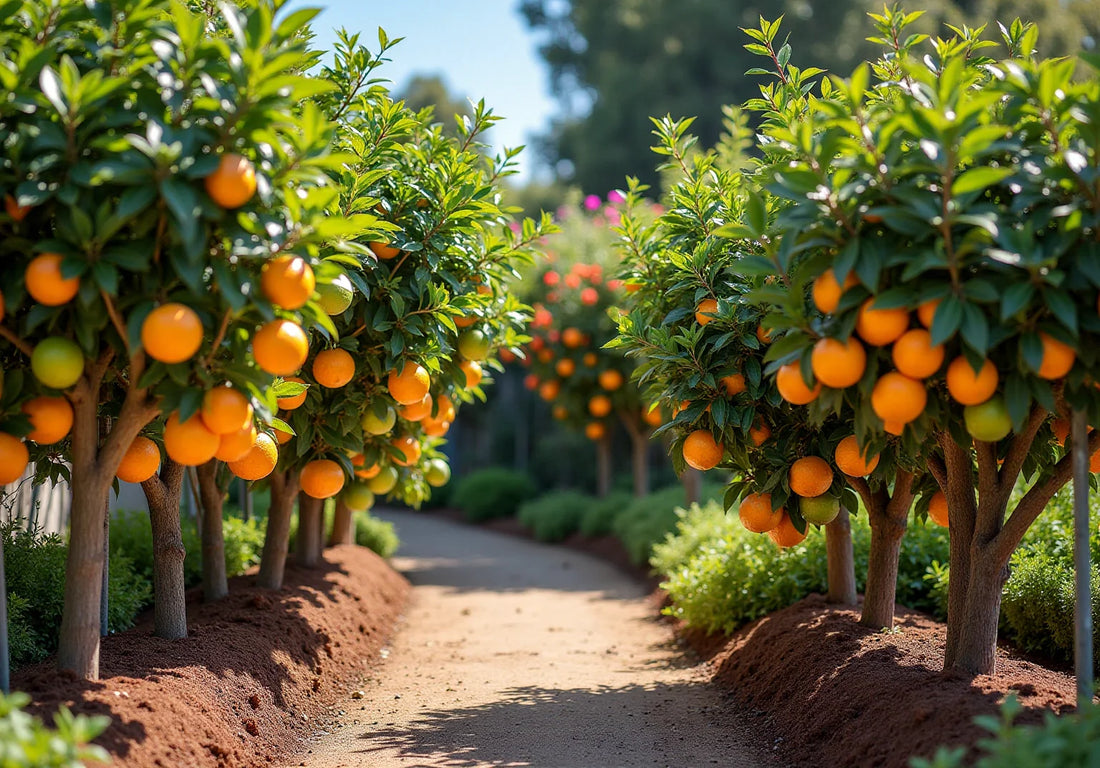
Identifying Citrus Trees: A Guide for Home Gardeners
Share
The article offers a comprehensive step-by-step guide designed for home gardeners to accurately identify various citrus trees. It emphasizes unique characteristics, including leaf shape, fruit size, and tree height. This method is bolstered by detailed descriptions of popular citrus varieties and practical identification strategies. As a result, gardeners can enhance their cultivation experience while ensuring proper care for their plants.
Thinking about growing citrus trees in your garden?
Explore Citrus Trees Collection at Everglades Farm - shipped directly from Florida.
Citrus trees present a vibrant addition to any garden, with their diverse varieties each offering unique flavors and characteristics. For home gardeners eager to cultivate their own citrus collection, understanding how to identify these trees is essential for successful cultivation and care. With numerous types—from sweet oranges to tangy lemons—distinguishing between them can be a challenge. This guide offers a step-by-step approach to recognizing citrus trees, empowering gardeners to enhance their green spaces while avoiding common pitfalls in identification.
Understand Citrus Tree Varieties
Citrus trees encompass a diverse range of varieties, each showcasing unique characteristics that cater to different gardening preferences. Understanding these popular types among home gardeners in 2025 can significantly enhance your gardening experience:
- Oranges: Known for their sweet flavor, oranges typically present as round fruits with a thick, bumpy rind. The Navel and Valencia varieties are particularly valued for their juiciness and versatility in culinary applications. Established in 1910, the Givaudan Citrus Variety Collection highlights the rich history and diversity of orange varieties.
- Lemons: These trees yield oval-shaped fruit with a vibrant yellow color. Their oval foliage features finely serrated edges, making them easily recognizable. Lemons are cherished for their tartness and are essential in numerous recipes. Expert Jude Grosser emphasizes that lemons play a vital role in enhancing culinary experiences.
- Limes: Smaller than lemons, lime trees produce round, green fruit commonly used in beverages and cooking. Their glossy leaves resemble those of lemon trees but are shinier, adding to their ornamental value. Cold-hardy varieties like Calamondin can thrive in temperatures as low as 20°F, making them suitable for various climates.
- Grapefruits: Larger in size, grapefruit trees yield fruit that can be yellow or pink, depending on the variety. The dark green, glossy leaves contribute to their lush appearance, making them a striking addition to any garden. The Citrus Experiment Station, founded in 1907, has played a crucial role in researching grapefruit varieties.
- Mandarins: These smaller fruit varieties are celebrated for their easy peeling and sweet flavor. Mandarins exhibit a bushy growth habit, making them ideal for home gardens with limited space. The , known for its cold-hardiness to about 18°F, is an excellent choice for gardeners in cooler regions.
By comprehending these types and their distinctive traits, you can better recognize them in your garden, which is essential for identifying citrus trees and facilitating the cultivation of a thriving fruit collection. Recent studies on new fruit types for HLB resistance underscore the importance of selecting appropriate varieties to ensure a successful and fruitful garden.
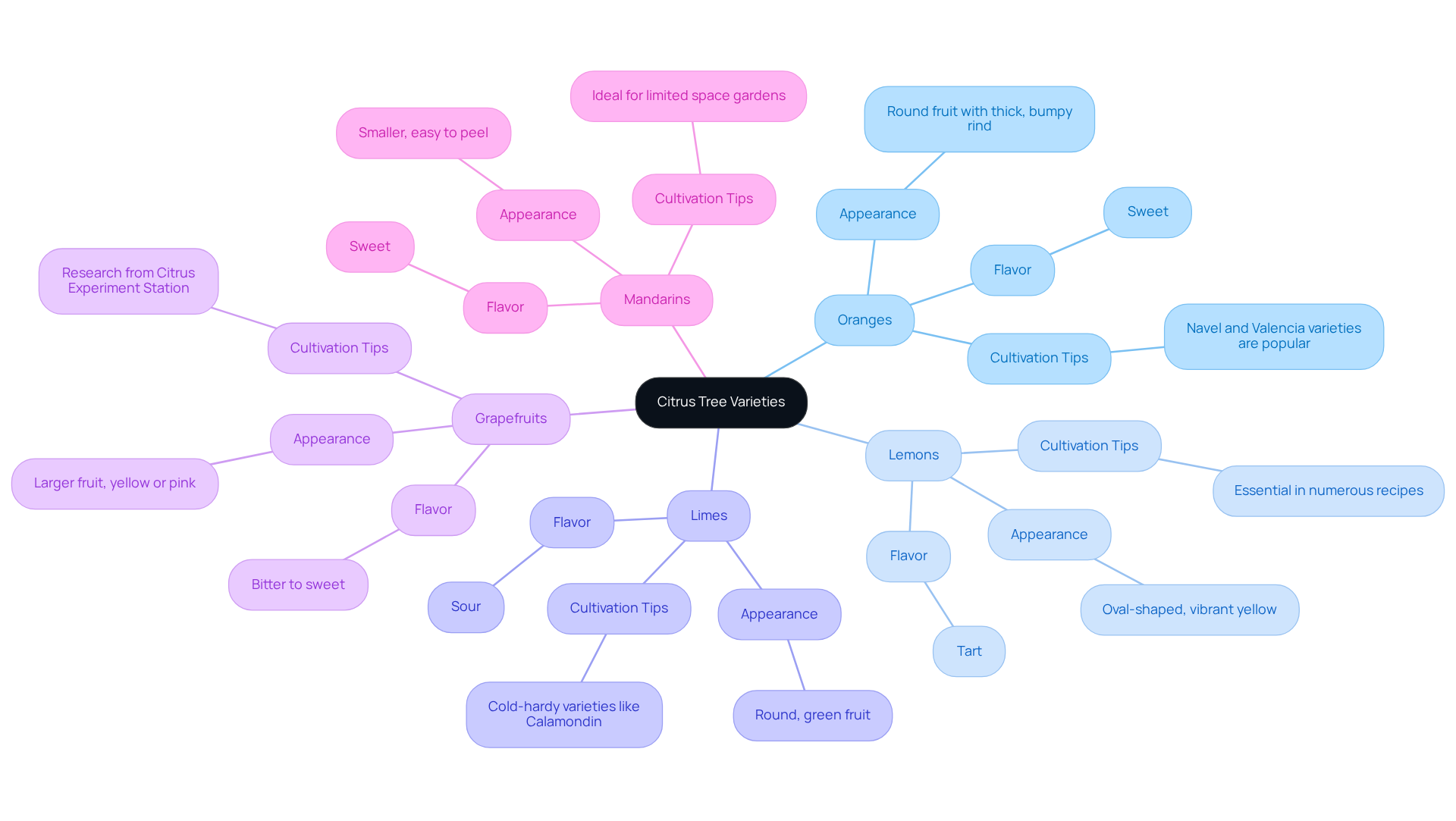
Identify Key Characteristics of Citrus Trees
To accurately identify citrus trees, focus on the following key characteristics:
- Leaf Shape: Citrus leaves exhibit a variety of shapes. For instance, lemon foliage is typically elliptical, while orange foliage is broader and more rounded. This distinction is crucial for identifying citrus trees properly.
- Leaf Color: Most citrus leaves are a rich dark green, although some varieties may display lighter shades or even variegated patterns, adding to their visual appeal.
- Fruit Size and Color: The size and color of the fruit are also telling features. Oranges are generally larger and bright orange, whereas limes are smaller and green, providing a clear contrast.
- Thorns: Some fruit varieties, such as particular orange plants, may possess thorns on their branches. This attribute can act as a distinguishing trait when recognizing various kinds of fruit-bearing plants.
When it is important to note that citrus plants vary significantly in height and shape. For instance, mandarins tend to be short and bushy, while grapefruit plants are taller and more slender, with an average height of about 3 meters, which can assist in identification.
As Ali Hassanpoor Tichi noted, "The fiber length, fiber lumen diameter, fiber diameter, and cell wall thickness decreased from the pith toward the bark," which reflects the structural characteristics that can also aid in identification. By meticulously examining these traits, you can efficiently reduce the options and correctly recognize fruit-bearing plants in your garden, which is crucial for identifying citrus trees and maintaining their health to maximize production.
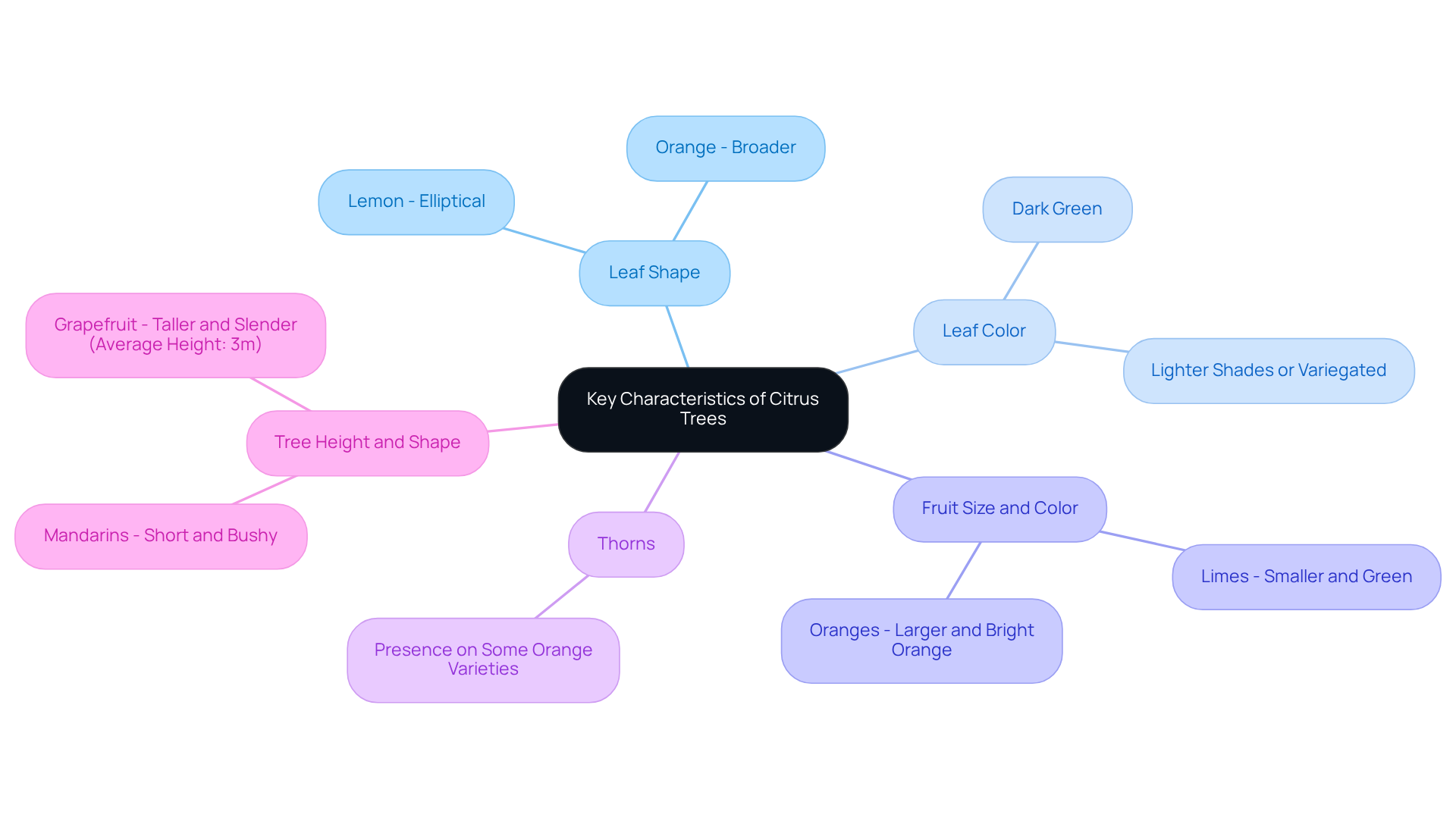
Follow a Step-by-Step Identification Process
To identify a citrus tree, follow these steps:
- Observe the Tree's Size and Shape: Begin by determining whether the tree is tall and slender or short and bushy. This initial observation can significantly narrow down the possibilities.
- Examine the Leaves: Take a close look at the leaves, noting their shape, size, and color. Are they glossy or matte? Are they serrated or smooth? These characteristics are crucial for the process of identifying citrus trees accurately.
- Check for Thorns: Inspect the branches for thorns. Certain citrus types, such as some oranges, may have thorns, while others, like lemons, typically do not.
- Inspect the Fruit: If the tree is bearing fruit, examine the size, color, and shape of the fruit. Is it round, oval, or oblong? What color is it? For instance, the is approximately 46.7 mm, which can aid in recognizing the specific type.
- Smell the Leaves: Crush a leaf and take a whiff. Different types of fruit release unique aromas, providing useful hints in the identification process.
- Consult Resources: Utilize guides or apps to compare your observations with known varieties. Online databases and local gardening groups can offer invaluable support and insights. As Greg Alder points out, "Since there is a fruit-bearing plant in nearly every yard in California, we frequently acquire one when we relocate to a new home," highlighting the prevalence and importance of understanding these plants.
By systematically following these steps and utilizing available resources, you can effectively engage in identifying citrus trees, thereby enhancing your gardening experience and knowledge.
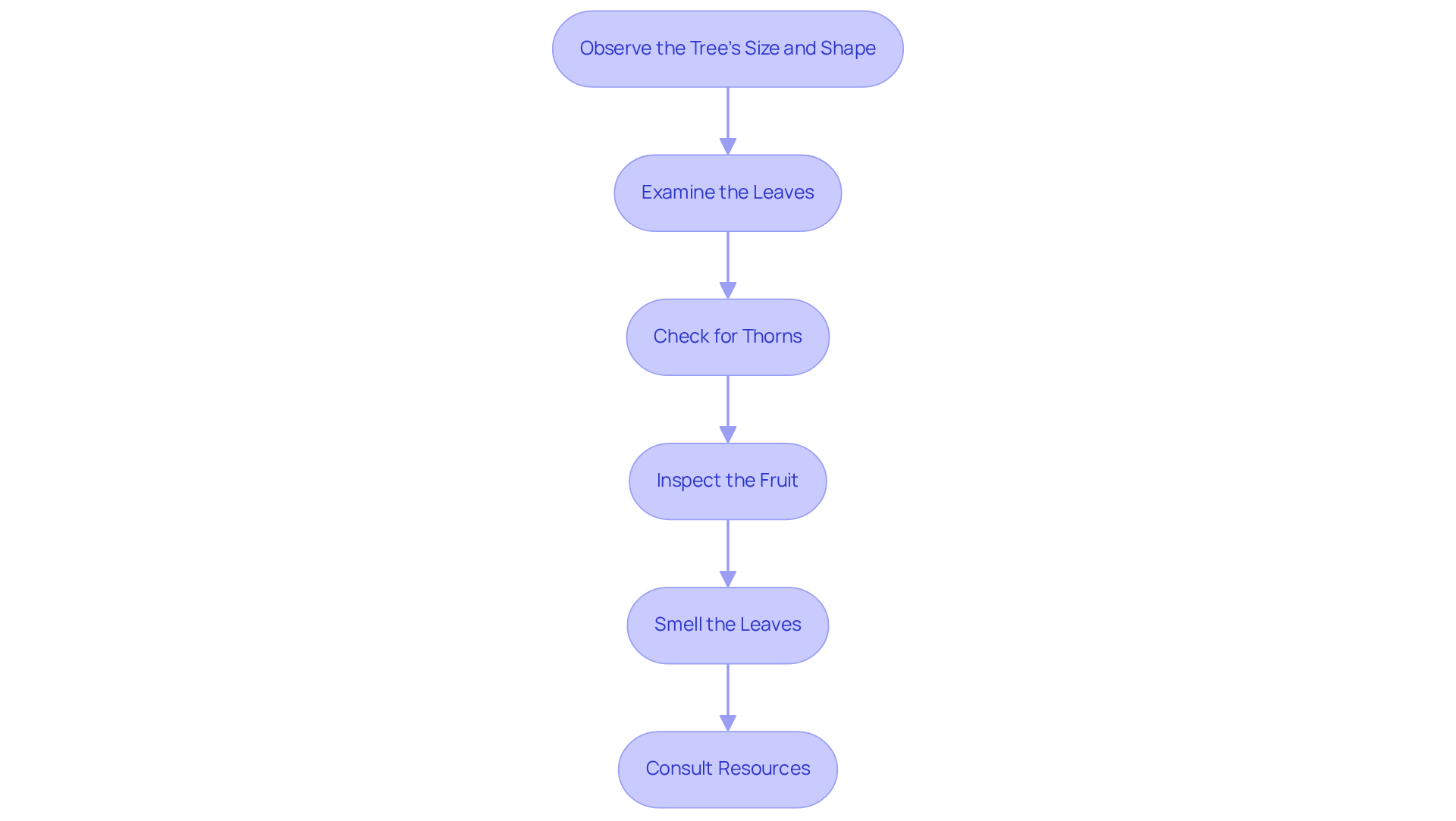
Troubleshoot Common Identification Issues
Identifying citrus trees can present several common challenges. To troubleshoot these issues effectively, consider the following strategies:
- Similar Leaf Shapes: When two trees exhibit similar leaf shapes, differentiate them by examining other characteristics such as fruit size and overall tree height.
- Lack of Fruit: If a plant is not yielding fruit, concentrate on its leaf features and growth pattern. Seasonal changes can significantly influence fruiting patterns. Remember that identifying citrus trees is crucial for care, as citrus plants can perish within 3 to 5 years if not managed properly.
- Inconsistent Growth: Variations in growth can stem from environmental factors. Evaluate the plant's growing conditions, including sunlight exposure and soil type, to understand these discrepancies better.
- Pest Damage: Pests can significantly alter the appearance of leaves and fruit. Look for signs of damage, such as holes or discoloration, which may complicate identification. According to Dr. Michael Rogers, effective pest management is essential to prevent damage that can hinder proper identification.
- Hybrid Varieties: Certain fruit-bearing plants are hybrids, complicating identification. In such cases, seeking guidance from a local expert or extension service can provide valuable assistance. Case studies have demonstrated that misidentification can result in inadequate care, further complicating the health of the plant.
By recognizing these common issues and knowing how to address them, you can enhance your skills in identifying citrus trees and gain confidence in this area.
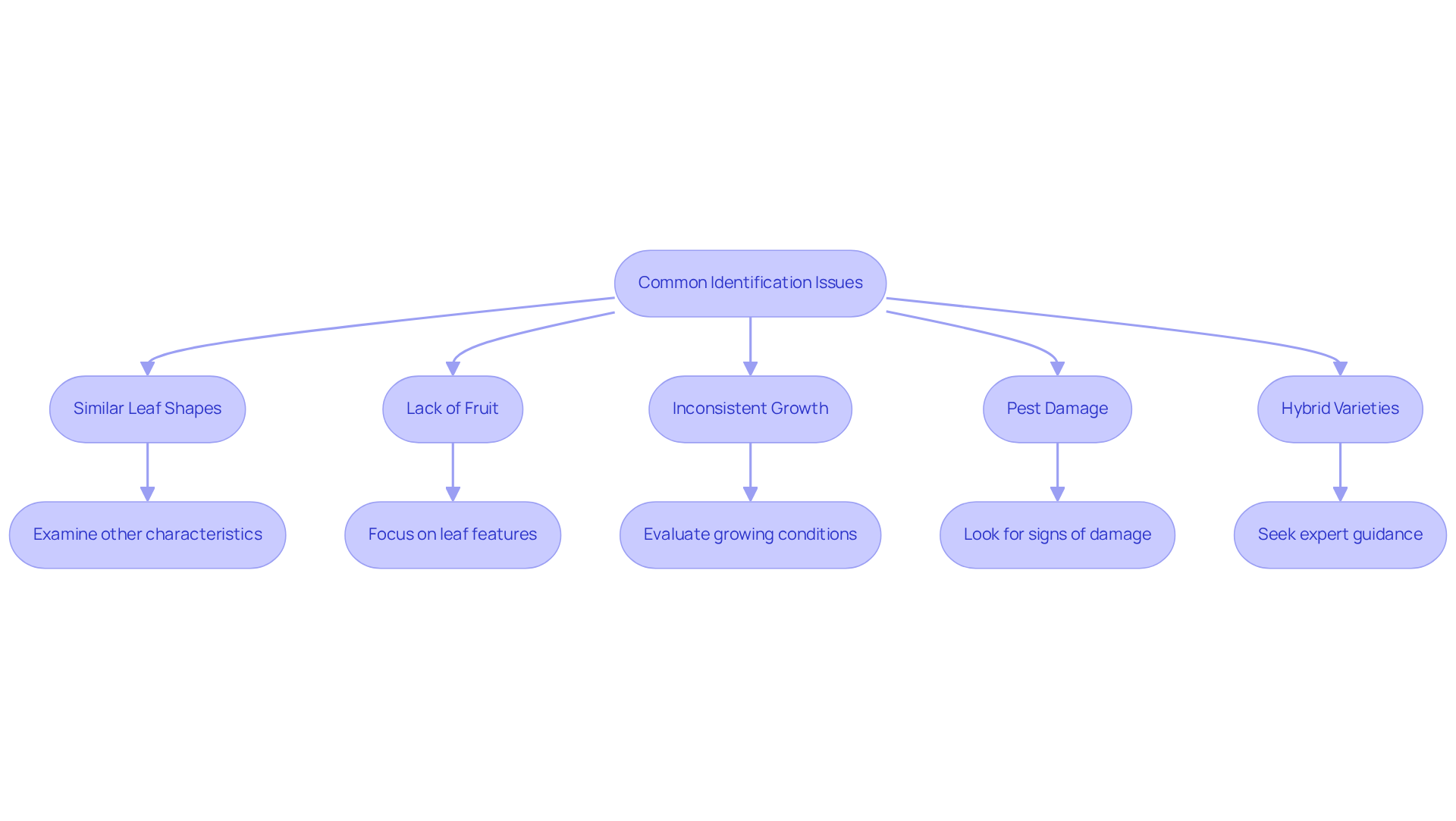
Conclusion
Understanding the diverse world of citrus trees is essential for home gardeners aiming to cultivate a fruitful and vibrant garden. Familiarizing oneself with various types of citrus trees, including oranges, lemons, limes, grapefruits, and mandarins, enhances gardeners' ability to identify these plants and appreciate their unique characteristics. This knowledge not only enriches the gardening experience but also aids in successful cultivation and care.
Key points include:
- The importance of observing specific traits such as leaf shape, color, fruit size, and the presence of thorns.
- A systematic approach to identification, involving careful examination and the use of resources, equips gardeners with the tools needed to distinguish between different varieties effectively.
- Understanding common identification challenges and strategies to troubleshoot these issues fosters greater confidence and skill in managing citrus trees.
Ultimately, the journey of identifying citrus trees can lead to a more rewarding gardening experience. By engaging with the characteristics and nuances of these plants, gardeners are encouraged to deepen their understanding and appreciation of citrus cultivation. Whether planting a single tree or nurturing an entire orchard, embracing this knowledge paves the way for a thriving and fruitful gardening endeavor.
Unlock the Secrets of Citrus Gardening Today!
Start your journey with Everglades Farm and cultivate a vibrant, fruitful garden with our premium tropical trees.
Frequently Asked Questions
What are the main types of citrus trees mentioned in the article?
The main types of citrus trees mentioned are oranges, lemons, limes, grapefruits, and mandarins.
What are the characteristics of orange trees?
Orange trees produce round fruits with a thick, bumpy rind and are known for their sweet flavor. The Navel and Valencia varieties are particularly valued for their juiciness and versatility in culinary applications.
How do lemon trees differ from other citrus trees?
Lemon trees yield oval-shaped fruit that is vibrant yellow and known for its tartness. Their foliage is oval with finely serrated edges, making them easily recognizable.
What is unique about lime trees?
Lime trees produce smaller, round, green fruit commonly used in beverages and cooking. They have glossy leaves similar to lemon trees but shinier, and cold-hardy varieties like Calamondin can survive temperatures as low as 20°F.
What distinguishes grapefruit trees from other citrus varieties?
Grapefruit trees yield larger fruit that can be yellow or pink, depending on the variety. They have dark green, glossy leaves that enhance their ornamental appeal, and research on grapefruit varieties has been conducted since the establishment of the Citrus Experiment Station in 1907.
What are the benefits of growing mandarins?
Mandarins are smaller fruit varieties known for their easy peeling and sweet flavor. They have a bushy growth habit, making them suitable for home gardens with limited space. The Nagami kumquat is a cold-hardy option for cooler regions.
Why is it important to understand different citrus tree varieties?
Understanding different citrus tree varieties helps gardeners recognize them in their gardens, facilitating the cultivation of a thriving fruit collection. Selecting appropriate varieties is also essential for ensuring a successful garden, especially in light of recent studies on new fruit types for HLB resistance.


